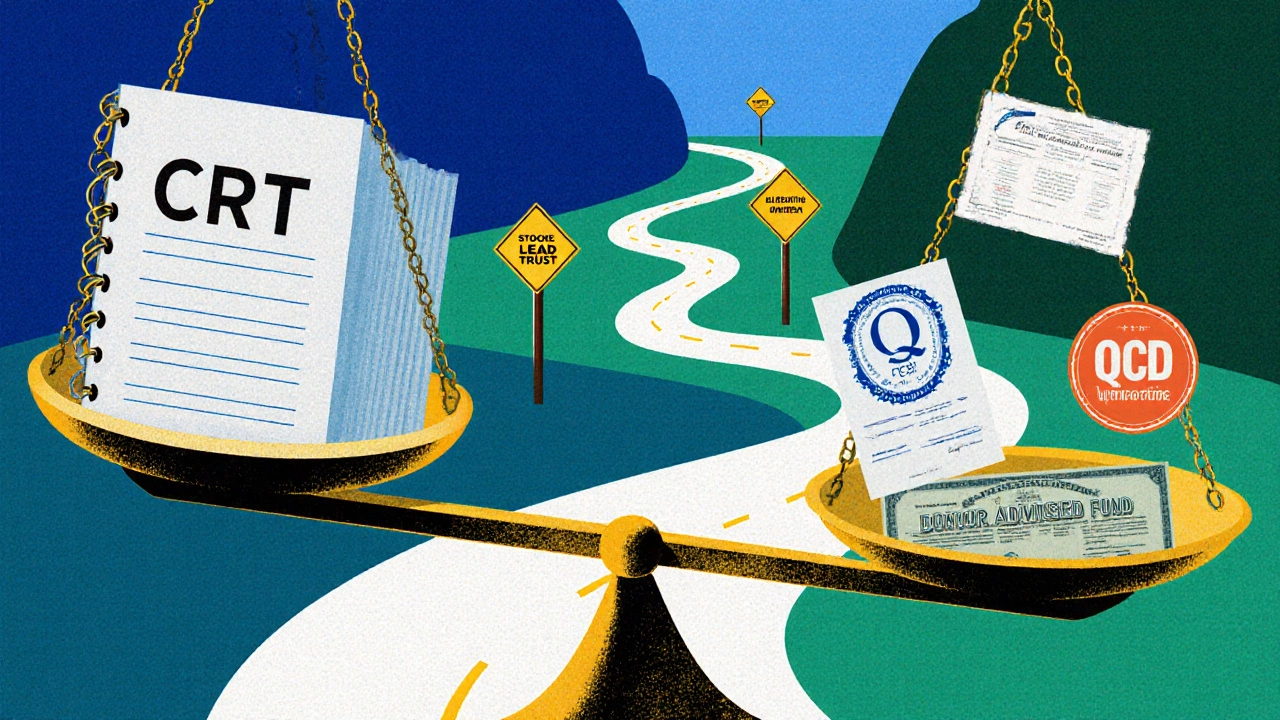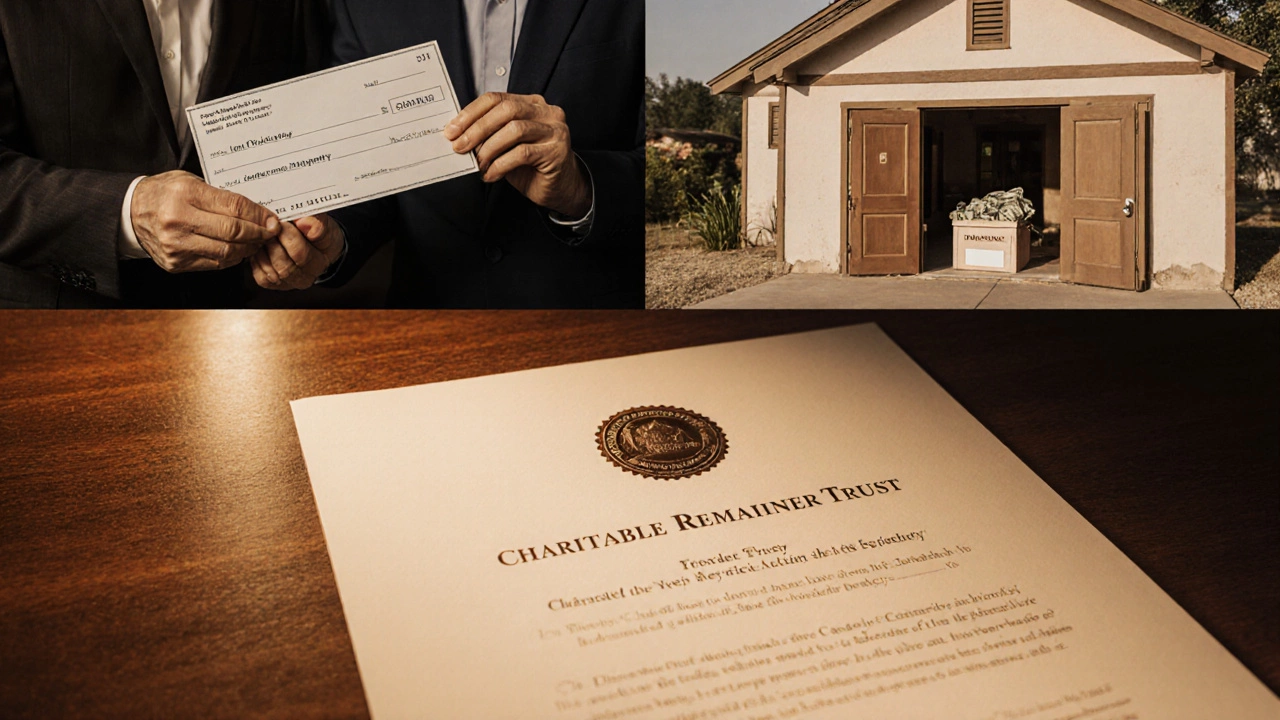CRT Risk Assessment Tool
Personalized CRT Risk Assessment
This tool helps you evaluate potential drawbacks of a Charitable Remainder Trust based on your specific financial situation. Enter your details below to receive a risk assessment.
When you hear Charitable Remainder Trust is an irrevocable trust that provides income to non‑charitable beneficiaries for a set term, then donates the remaining assets to a qualified charity, it sounds like a win‑win. But like any financial tool, it comes with its own set of drawbacks. This guide walks you through the most common Charitable Remainder Trust disadvantages so you can decide whether the trade‑offs fit your goals.
Understanding a Charitable Remainder Trust
A Charitable Remainder Trust can be structured as a Charitable Remainder Annuity Trust (CRAT) or a Charitable Remainder Unitrust (CRUT). After you fund the trust, a chosen income beneficiary-often yourself-receives a fixed (CRAT) or variable (CRUT) payment for life or a term of up to 20 years. When the trust term ends, the remaining assets move to one or more charitable organizations that meet the IRS definition of a qualified charity.
The IRS U.S. Internal Revenue Service, which enforces tax rules for trusts governs CRTs under Section 664 the Internal Revenue Code provision governing charitable remainder trusts. Compliance with Section 664 is essential; otherwise the trust can lose its tax‑exempt status, turning a charitable strategy into a costly mistake.
Key Disadvantages to Watch
- Irrevocability - Once you transfer assets into a CRT, you cannot undo the move. Even if your financial situation changes, the trust remains locked.
- Complexity and Setup Costs - Drafting a CRT requires a qualified attorney, a financial advisor, and often a trust administrator. Legal fees can run $2,000‑$5,000, and annual administration can add another $1,000‑$2,500.
- Uncertain Income Stream - With a CRUT, payments fluctuate based on the trust’s investment performance. If the market tanks, your annual income may dip below expectations.
- Tax Implications - While you receive an immediate charitable income‑tax deduction, the deduction is subject to limits (usually 30% of adjusted gross income for cash contributions, 20% for appreciated assets). Excess deductions must be carried forward for up to five years.
- Estate Planning Trade‑offs - A CRT removes assets from your taxable estate, which can be advantageous, but it also reduces the pool of assets you can directly bequeath to heirs. Some families view this loss of control as a drawback.
- Limited Charitable Control - After the trust term, the remainder goes to the named charity, but you cannot later redirect it. If the charity’s mission changes, the assets are still bound to it.
- Potential for Mismanagement - The trust’s investments are managed by a trustee or investment advisor. Poor investment choices can erode both income and remainder value.
- Required Minimum Distribution (RMD) Rules - The IRS mandates that a CRT distribute at least 5% of the trust’s assets annually (or a higher rate defined in the trust). This rule can force sales of appreciated assets, triggering capital‑gains tax for the trust.
How These Drawbacks Affect Different Stakeholders
Donors may find the irrevocability and loss of direct control unsettling, especially if they anticipate needing liquidity later. The upfront costs can also eat into the net benefit, making the trust less attractive for smaller estates.
Income beneficiaries-typically the donor or family members-face income uncertainty, particularly with a CRUT during market downturns. If the trust’s assets shrink, the annual payout may not meet living expenses.
Charities benefit from a future endowment, but they receive no say in how the trust is funded or invested. If the donor’s chosen assets underperform, the remainder could be far smaller than projected.

Mitigating the Risks
- Choose the Right Trust Type - A CRAT provides a predictable, fixed payment, reducing income volatility. A CRUT offers flexibility for growth but should be paired with a conservative payout rate (e.g., 4%-5%).
- Work with Experienced Professionals - A qualified estate‑planning attorney, a CPA familiar with charitable tax law, and a reputable trust company can help you avoid compliance pitfalls.
- Set a Realistic Distribution Rate - Selecting a lower payout rate leaves more assets to appreciate, preserving the charitable remainder and cushioning against market swings.
- Diversify Trust Investments - Include a mix of equities, bonds, and cash equivalents. Diversification helps smooth income and protects the remainder value.
- Plan for Tax Carryforwards - If your charitable deduction exceeds the annual AGI limit, coordinate with a tax advisor to make sure you can use the carryforward years effectively.
- Include Contingency Clauses - Some CRTs allow a backup charitable beneficiary or a provision to adjust the payout if the trust’s assets fall below a certain threshold.
Alternative Giving Vehicles
If the disadvantages of a CRT feel too heavy, consider these options:
- Donor‑Advised Funds (DAFs) - You contribute assets, receive an immediate tax deduction, and recommend grants to charities over time. DAFs are revocable and have lower setup costs.
- Charitable Lead Trusts (CLTs) - The charity receives income first, and the remainder goes to heirs, potentially reducing estate tax while preserving wealth for the family.
- Direct Gifts of Appreciated Securities - You avoid capital‑gains tax and receive a charitable deduction equal to the fair market value, though you lose the ability to generate income from the asset.
- Qualified Charitable Distributions (QCDs) - For IRA owners over 70½, up to $100,000 can be transferred directly to a charity, counting toward required minimum distributions without taxable income.

Checklist Before Setting Up a CRT
- Confirm the charity is a qualified Tax‑Exempt Organization a 501(c)(3) entity recognized by the IRS.
- Determine whether a CRAT or CRUT aligns with your income needs and risk tolerance.
- Calculate the expected charitable income‑tax deduction and check the AGI limits.
- Project the trust’s investment performance and ensure the payout rate won’t trigger forced asset sales.
- Engage a qualified attorney and a CPA to draft the trust document and ensure compliance with Section 664.
- Obtain a written estimate of all legal, administrative, and investment fees.
- Discuss the plan with family members to address expectations around income and legacy.
- Set up a monitoring schedule-annual review of trust assets, income distributions, and charitable impact.
Frequently Asked Questions
Can I change the charity after the trust is created?
Generally no. Once the trust deed names a charitable beneficiary, that designation is fixed. Some trusts include a backup charity clause, but changing the primary recipient requires a court order and is rarely granted.
What happens if the trust’s assets run out before the term ends?
If the trust cannot meet its required payout, the trustee must liquidate assets, potentially realizing capital gains that are taxed at the trust level. If assets truly deplete, the charitable remainder may be reduced or eliminated, which could affect the donor’s tax deduction credibility.
Do I still get a tax deduction if I fund the CRT with a highly appreciated stock?
Yes. The deduction equals the fair market value of the stock on the contribution date, and the trust can sell the stock without incurring capital‑gains tax. This is one of the main tax advantages of a CRT.
How does a CRT affect my estate tax liability?
Assets transferred to a CRT are removed from your taxable estate, potentially lowering estate‑tax exposure. However, the value of the charitable remainder is subtracted from the estate, which means fewer assets are available for heirs.
Is a CRT suitable for small estates?
Because of setup costs and minimum payout requirements, CRTs usually make sense for estates with at least $500,000 in assets. For smaller amounts, a donor‑advised fund or direct charitable gift may be more efficient.
Bottom Line
A Charitable Remainder Trust can deliver tax benefits, income, and a lasting charitable legacy, but it’s not without trade‑offs. Irrevocability, administrative expenses, income uncertainty, and strict IRS rules can turn a well‑intended plan into a financial burden if you don’t plan carefully. By weighing these disadvantages against your goals, consulting seasoned professionals, and considering alternative giving vehicles, you can decide whether a CRT truly fits your philanthropic strategy.






